Respiratory insufficiency correlated strongly with mortality of rodents infected with West Nile virus
- PMID: 22719920
- PMCID: PMC3375279
- DOI: 10.1371/journal.pone.0038672
Respiratory insufficiency correlated strongly with mortality of rodents infected with West Nile virus
Abstract
West Nile virus (WNV) disease can be fatal for high-risk patients. Since WNV or its antigens have been identified in multiple anatomical locations of the central nervous system of persons or rodent models, one cannot know where to investigate the actual mechanism of mortality without careful studies in animal models. In this study, depressed respiratory functions measured by plethysmography correlated strongly with mortality. This respiratory distress, as well as reduced oxygen saturation, occurred beginning as early as 4 days before mortality. Affected medullary respiratory control cells may have contributed to the animals' respiratory insufficiency, because WNV antigen staining was present in neurons located in the ventrolateral medulla. Starvation or dehydration would be irrelevant in people, but could cause death in rodents due to lethargy or loss of appetite. Animal experiments were performed to exclude this possibility. Plasma ketones were increased in moribund infected hamsters, but late-stage starvation markers were not apparent. Moreover, daily subcutaneous administration of 5% dextrose in physiological saline solution did not improve survival or other disease signs. Therefore, infected hamsters did not die from starvation or dehydration. No cerebral edema was apparent in WNV- or sham-infected hamsters as determined by comparing wet-to-total weight ratios of brains, or by evaluating blood-brain-barrier permeability using Evans blue dye penetration into brains. Limited vasculitis was present in the right atrium of the heart of infected hamsters, but abnormal electrocardiograms for several days leading up to mortality did not occur. Since respiratory insufficiency was strongly correlated with mortality more than any other pathological parameter, it is the likely cause of death in rodents. These animal data and a poor prognosis for persons with respiratory insufficiency support the hypothesis that neurological lesions affecting respiratory function may be the primary cause of human WNV-induced death.
Conflict of interest statement
Figures
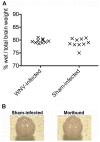

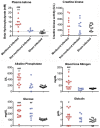
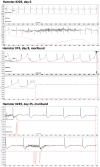

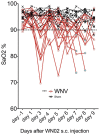
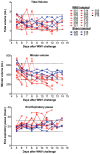

Similar articles
-
Neurological approaches for investigating West Nile virus disease and its treatment in rodents.Antiviral Res. 2013 Nov;100(2):535-45. doi: 10.1016/j.antiviral.2013.09.010. Epub 2013 Sep 19. Antiviral Res. 2013. PMID: 24055448 Free PMC article. Review.
-
Increased blood-brain barrier permeability is not a primary determinant for lethality of West Nile virus infection in rodents.J Gen Virol. 2008 Feb;89(Pt 2):467-473. doi: 10.1099/vir.0.83345-0. J Gen Virol. 2008. PMID: 18198377
-
Autonomic deficit not the cause of death in West Nile virus neurological disease.Clin Auton Res. 2014 Feb;24(1):15-23. doi: 10.1007/s10286-013-0213-y. Epub 2013 Oct 25. Clin Auton Res. 2014. PMID: 24158383 Free PMC article.
-
Neurological suppression of diaphragm electromyographs in hamsters infected with West Nile virus.J Neurovirol. 2010 Jul;16(4):318-29. doi: 10.3109/13550284.2010.501847. J Neurovirol. 2010. PMID: 20632796 Free PMC article.
-
West Nile virus and kidney disease.Expert Rev Anti Infect Ther. 2013 May;11(5):479-87. doi: 10.1586/eri.13.34. Expert Rev Anti Infect Ther. 2013. PMID: 23627854 Review.
Cited by
-
West Nile Disease Symptoms and Comorbidities: A Systematic Review and Analysis of Cases.Trop Med Infect Dis. 2022 Sep 8;7(9):236. doi: 10.3390/tropicalmed7090236. Trop Med Infect Dis. 2022. PMID: 36136647 Free PMC article. Review.
-
Neurological approaches for investigating West Nile virus disease and its treatment in rodents.Antiviral Res. 2013 Nov;100(2):535-45. doi: 10.1016/j.antiviral.2013.09.010. Epub 2013 Sep 19. Antiviral Res. 2013. PMID: 24055448 Free PMC article. Review.
-
Comparison of the neuropathology induced by two West Nile virus strains.PLoS One. 2013 Dec 18;8(12):e84473. doi: 10.1371/journal.pone.0084473. eCollection 2013. PLoS One. 2013. PMID: 24367664 Free PMC article.
-
RSV vaccine-enhanced disease is orchestrated by the combined actions of distinct CD4 T cell subsets.PLoS Pathog. 2015 Mar 13;11(3):e1004757. doi: 10.1371/journal.ppat.1004757. eCollection 2015 Mar. PLoS Pathog. 2015. PMID: 25769044 Free PMC article.
-
Bugs in the system.Immunol Rev. 2013 Sep;255(1):256-74. doi: 10.1111/imr.12092. Immunol Rev. 2013. PMID: 23947361 Free PMC article. Review.
References
-
- Lindsey NP, Staples JE, Lehman JA, Fischer M. Surveillance for human West Nile virus disease - United States, 1999–2008. MMWR Surveill Summ. 2010;59:1–17. - PubMed
-
- Morrey JD, Day CW, Julander JG, Olsen AL, Sidwell RW, et al. Modeling hamsters for evaluating West Nile virus therapies. Antiviral Res. 2004;63:41–50. - PubMed
-
- Leis AA, Stokic DS. Neuromuscular Manifestations of Human West Nile Virus Infection. Curr Treat Options Neurol. 2005;7:15–22. - PubMed
Publication types
MeSH terms
Grants and funding
LinkOut - more resources
Full Text Sources
Medical

